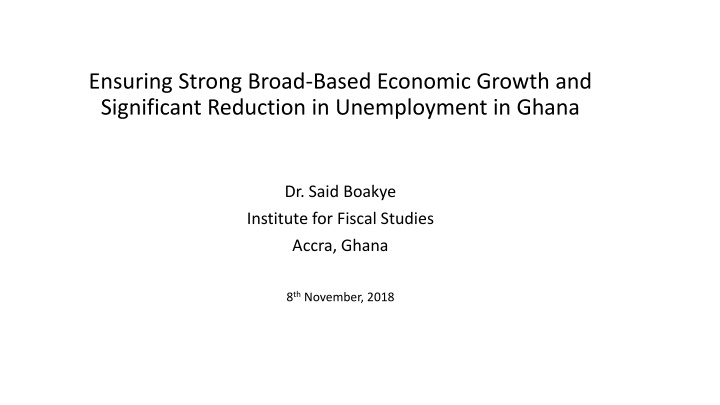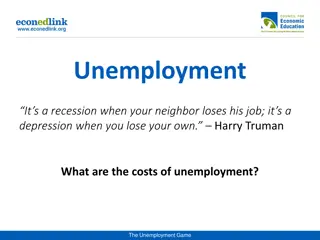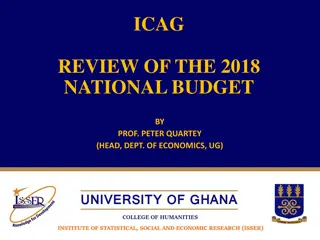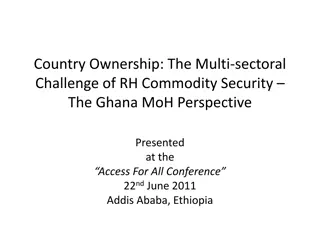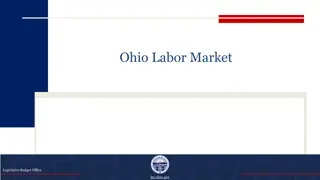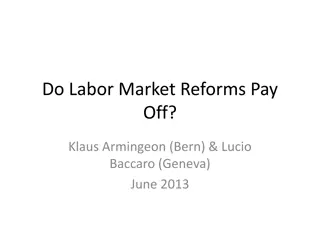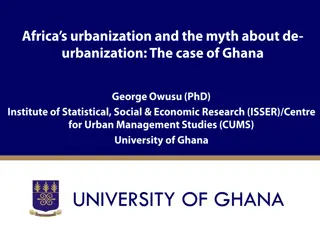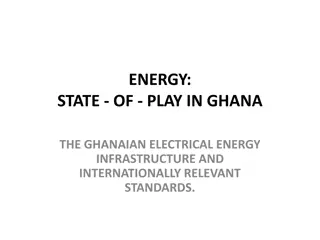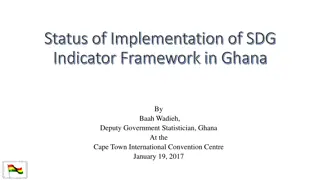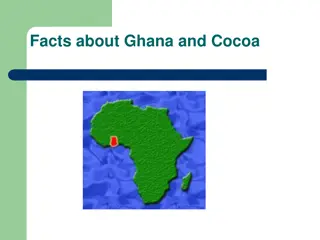Analysis of Economic Growth and Unemployment Trends in Ghana
Analysis of economic growth and unemployment trends in Ghana since 1993 reveals fluctuations in real GDP growth rates, with a notable decline in non-oil sectors leading to high unemployment rates, particularly among the youth. Recommendations are provided to address these challenges through strong broad-based economic growth strategies.
Download Presentation

Please find below an Image/Link to download the presentation.
The content on the website is provided AS IS for your information and personal use only. It may not be sold, licensed, or shared on other websites without obtaining consent from the author.If you encounter any issues during the download, it is possible that the publisher has removed the file from their server.
You are allowed to download the files provided on this website for personal or commercial use, subject to the condition that they are used lawfully. All files are the property of their respective owners.
The content on the website is provided AS IS for your information and personal use only. It may not be sold, licensed, or shared on other websites without obtaining consent from the author.
E N D
Presentation Transcript
Ensuring Strong Broad-Based Economic Growth and Significant Reduction in Unemployment in Ghana Dr. Said Boakye Institute for Fiscal Studies Accra, Ghana 8thNovember, 2018
Introduction Starting from 2013, growth of both total and non-oil real GDP began to decline, reaching incredibly low rates from 2014 to 2016. In 2017, the economy saw a strong growth performance. However, this growth almost entirely came from the oil sector. The traditional non-oil sector continued to grow at a comparatively low rate. As a consequence, unemployment, particularly among the youth, is soaring. To ensure significant generation of jobs and minimize the problem of unemployment, strong broad-based economic growth is critically needed.
Introduction (contd) We provide recommendations to help the government fine-tune its policies in this regard to ensure policy effectiveness and the avoidance of complications. To do this, we first provide a quick review of economic growth and unemployment rates in Ghana since 1993. demonstrate the relationship between these two variables during the period. discuss the approach the government has so far taken to address these issues. provide a critical analysis of the government s policy approach
Review of Economic Growth and Unemployment since 1993 Economic Growth Economic growth declined in the 1990s: Average growth rate of real GDP decreased from 5.3% in 1984-1992 to 4.3% in 1993- 2000. From 2001 to 2008, average real GDP growth rate improved to 5.6%. This thus exceeded the average real GDP growth rate recorded in 1984-1992 by 0.3%. In 2009-2012, real GDP growth performed exceptionally good. Total real GDP growth rate increased to a whopping 9.0% on average. The highest 4 consecutive year average in the country s post-independence history. Even excluding the oil sector, average real GDP growth rate stood at as high as 7.4% in 2009-2012. Also the highest average non-oil real GDP growth rate for 4 consecutive years of any administration in the country s post-independence history.
Review of Economic Growth and Unemployment since 1993 (contd) In 2013-2016, real GDP growth took a dramatic decline. Average total real GDP growth rate reduced 4.0%. And average non-oil real GDP growth rate reduced to 4.1%. In 2017, total real GDP growth rate increased sharply to 8.1% . This is clearly welcome news. However, this was driven by the oil sector (due to additional oil from TEN and Sankofa). The non-oil real GDP registered a growth rate of only 4.6% in 2017.
Table 1: AverageReal GDP Growth Rate (GR) in Different Periods Period Average Real GDP Growth Rate Total Non-oil 1984-1992 5.3 5.3 1993-2000 4.3 4.3 2001-2008 5.6 5.6 2009-2012 9.0 7.4 2013-2016* 4.0 4.1 2017* 8.1 4.6 *Using the recently released GDP data with 2013as the base year. Note: Using the previous GDP data with 2006 as the base year, average total real GDP and average non-oil real GDP growth rates in 2013-2016 stood at 4.7% and 4.9% respectively. For 2017, the previous GDP series put total real GDP and non-oil real GDP growth rate at 8.5% and 4.9% respectively. Source of Data: Ghana Statistical Service (GSS)
Review of Economic Growth and Unemployment since 1993 (contd) Unemployment From 4.7% in 1992, total unemployment rate in Ghana more that doubled to 10.4% in 2000, using data from the World Development Indicators of the World Bank. By the end of 2010, it had declined to 5.3%. It saw a further decline to 2.2% by the end of 2013. However, total unemployment rate saw another upward swing, increasing sharply to 6.8% by the end of 2015. Youth unemployment rate has been more problematic in Ghana, even though it has shown the same pattern of movement as total unemployment rate. Standing at 16.6% in 2000, youth unemployment rate declined to 11.2% in 2010, and further to 4.6% in 2013. However, it increased sharply to 15.2% in 2015.
Relationship Between Unemployment and Non-oil Real GDP Growth Rates Unemployment rates in Ghana are strongly determined by non-oil real GDP growth rate. High average non-oil real GDP growth rate during a period brings about strong decreases in total and youth unemployment rates at the end of the period, and vice versa.
Figure 1a: Relationship between Average Non-oil Real GDP Growth Rate and End-period Total Unemployment Rate in Ghana (%) Figure 1b: Relationship between Average Real GDP Growth Rate and End-period Youth Unemployment Rate in Ghana (%) 10.4 16.6 15.2 8 6.8 11.2 5.8 5.3 4.7 8 5.3 4.3 5.8 4.6 4.3 2.5 2.5 2.2 1993-2000 2001-2010 2011-2013 2014-2015 1984-1992 1993-2000 2001-2010 2011-2013 2014-2015 Av. GRnoil Youth Unemp R Av. GRnoil Unemp. R Implication: To have a strong handle over the problem of unemployment in Ghana, the government has to find ways to achieve strong growth in non-oil real GDP.
The Governments Policy Approach So Far The Government s Policy Approach So Far The government has recognized the need for broad-based economic growth as a means to minimize the problem of unemployment. According to the government, it is embarking on a three-pronged economic development program that will focus on, integrate and accelerate investments in: Agriculture Infrastructure, and Industrialization This will serve as the primary vehicle to fundamentally transform the economy.
The Governments Policy Approach So Far (contd) The Government s Policy Approach So Far (cont d) To achieve these, the government has proposed to aggressively pursue the following programs and initiatives: Infrastructure for Poverty Eradication Program (IPEP); One District, One Factor (1D1F); The National Industrialization Revitalization Program A Stimulus Package for Industry; Industrial Parks and Special Economic Zones; US$10 million National Entrepreneurship and Innovation Program (NEIP); Planting for Food and Jobs; Establishment of a GH 400 million Fund to de-risk Agriculture; Development of Modern Storage Facilities through One-district, One Warehouse program; Transformation (AAPET); the establishment of Zongo Development Fund to develop Zongos and inner cities into centers of opportunity; and others. The government has also launched the Nation Builders Corps (NABCO) to directly provide jobs for the youth, specifically university graduates. These are on top of high money-consuming initiatives like the Free Public Senior High School Programme; US$1 million for each constituency; etc. Akufo-Addo Program for Economic
Analysis of the Government Policies Analysis of the Government Policies It is commendable that the government has recognized the need for a broad-based approach to economic growth. However, the programs and initiatives are too many. Some of them are also too grandiose. They require very large amounts of funding. How can the government fund these numerous and grandiose programmes and initiatives, given that the country is on a fiscal consolidation path; government revenue has consistently fallen short of initial budgets since 2012; and there is presently no available free fiscal space, since three rigid expenditure items in the forms earmarked expenditure, compensation of employees and debt service expenditure have consistently exceeded total revenue and grants since 2013? For instance in 2017, these three rigid expenditure items alone amounted to GH 46.35 billion, exceeding total revenue and grants of GH 41.50 billion by 11.7%.
Analysis of the Government Policies (contd) Indeed, these programs and initiatives can only be accommodated if the government resorts to large amounts of borrowing. The government s recent announcement of its desire to borrow US$50 billion in a century bond is clearly the result of its inability to raise large sums of revenue to fund these numerous programs and initiatives. Large amounts of borrowing stands the risk of reversing the fiscal gains made in the past two years. Why? It will impose additional significant debt service burden. The country s fiscal state continues to be weak and fragile. Large amount of borrowing can therefore plunge the country into serious fiscal difficulties and macroeconomic instability.
Analysis of the Government Policies (contd) Question: Wouldn t investing the borrowed funds in the various programs and initiatives stimulate higher economic growth, which would help generate increased revenues in the future to pay for the borrowed amount? Answer: While increased pace of future growth cannot be completely ruled out, since it depends on how the borrowed amounts are invested, historical records show that Ghana has largely not been able to derive significant returns on public investments in terms of real GDP growth. Cases in point: 1993-2000 and 2013-2016 (let us see the next table).
Analysis of the Government Policies (contd) Table 3: The Historical Effects of Capital Expenditure (CAPEX) and Macroeconomic In/Stability on Real GDP Growth Rate in Ghana Macroeconomic Stability Variables Period Av. Non-oil GDP Growth Rate (%) CAPEX Ratio (%) Av. Infl. Rate (%) Av. Cedi Dep. Rate (%) 1993-2000 4.3 7.3 30.2 26.6 2001-2008 5.6 5.9 18.9 6.3 2009-2012 7.4 6.6 12.0 10.1 2013-2016 4.1 6.8* 15.5 17.8 Corr. with non-oil GDP Growth Rate -0.1 -0.61 -0.68 *Starting from 2013, the government ceased to include District Assemblies Common Fund, GETFund, Road Fund, Petroleum Related Funds, and Transfers to GNPC in the capital expenditure values in the fiscal tables. However, to make capital expenditure values in 2013-2016 comparable to those in other periods, these expenditure items have been included as part of capital expenditure in 2013-2016 also. The alternative to this approach is to exclude these expenditure items from capital expenditures since 1993. Interestingly, doing this does not change our conclusions, since the same relationships are maintained.
Analysis of the Government Policies (contd) Question: What is the explanation for such an insignificant effect of public investment on non-oil real GDP growth rate in Ghana? Answer? Large increases in public investments in Ghana have historically caused macroeconomic instability. For instance, the Correlation coefficient between public investment and the depreciation rate of the cedi against the US dollar in the data is as high as 0.94. Unfortunately, macroeconomic instability is a powerful depressor of non-oil real GDP growth rate. As shown by the previous table and the graphs below.
Figure 2b: Relationship between Average Depreciation Rate of the Cedi and Average Non-oil Real GDP Growth Rate in Ghana Figure 2a: Relationship between Average Inflation Rate and Average Non-oil Real GDP Growth Rate in Ghana 26.6 30.2 17.8 18.9 15.5 10.1 6.3 12.0 7.4 7.4 4.3 4.1 5.6 5.6 4.3 4.1 1993-2000 2001-2008 2009-2012 2013-2016 1993-2000 2001-2008 2009-2012 2013-2016 Av. Grnoil Av. Cedi Dep. Rate Av. Grnoil Av. Infl. Rate To recap, if history repeats itself, borrowing huge sums of money to fund the numerous program and initiatives of the government will have the potential to reverse the fiscal gains made and throw the country deeper into fiscal and debt distress, since real GDP growth rate may not increase as expected due to possible macroeconomic instability that may arise.
Analysis of the Government Policies (contd) On Industrialization, the question is: Are the current industrialization policies and programs different from what were pursued by the previous administrations by which one can be assured that they will not end up in failures as the previous ones largely did? In fact, the industrialization policies, programs and strategies being articulated by the Akufo Addo administration bear a great deal of resemblance to those of the Kufuor administration. So, again, given that the Kufuor administration s industrialization policies and programs did not yield any better results than those of the other previous governments, what can assure the nation that the industrialization policies of the Akufo Addo government will succeed, particularly given the current weak fiscal and financial positions of the country?
Analysis of the Government Policies (contd) Among the most important factors that have caused the failure of the various industrialization efforts in Ghana are: Lack of industrialization policy continuity due to the inability of the country to have a clear national industrialization strategy and vision acceptable to and championed by political actors across board; Macroeconomic instability caused by politically induced fiscal overruns, particularly during election years; Inadequate or poor industrialization project planning due to political rush, caused by the desire of political leaders to quickly use industrialization programs and projects to impress on voters for electoral gains; etc. Without addressing these critical undermining factors on a long-term basis, the industrialization efforts of the current government are very likely to be unsuccessful as those of the previous governments.
Analysis of the Government Policies (contd) Notes: The debate about state-led and private-sector led industrialization approaches, which was particularly intense during the early stage of the country s development, has been needless. Why? Singapore and South Korea adopted different approaches but both succeeded in their industrialization efforts. What benefited both of these countries is industrialization policy continuity for quite a long period of time, unlike what Ghana has continuously experienced. Addressing the above undermining factors is not only needed for the success of the government s industrialization efforts, but it is also needed to ensure the success of the other programs and initiatives in the agriculture and infrastructure sectors.
Policy Recommendations Policy Recommendations We have argued that a broad-based approach to economic growth is critically needed in order to meaningfully create jobs and reduce the problem of unemployment. We therefore recommend that the government should continue to pursue its multi-pronged approach to economic growth and development. However, if care is not taken, the aggressive move by the government can backfire, which can plunge the country into an economic mess in the future. To ensure that this does not happen, the IFS makes the following recommendations: Given the weak fiscal state in which the country finds itself in terms of the lack of free fiscal space to maneuver, which is caused by the weak revenue generating capacity of the state and the excessive fiscal rigidity in the budget, the government should consider pruning down the numerous programs and initiatives it is pursuing. In trying to fund the programs and initiatives to ensure broad-based economic growth, the government should limit the amount of money it borrows to the barest minimum, in order not to cause fiscal overruns and generate macroeconomic instability, since macroeconomic instability is a powerful depressor of real GDP growth in Ghana.
Policy Recommendations (contd) Policy Recommendations (cont d) Given the weak fiscal and financial positions of the country, it is critical that any investments made from borrowed funds be fully informed by economic returns and not political or unjustifiable social considerations. This will make the country stand the chance of getting positive returns in terms of increase in real GDP growth from public investments, unlike what the historical records show. To be able to genuinely transform the economy of Ghana though industrialization so as to achieve sustainable growth, generate high quality jobs and significantly reduce unemployment, the government, through NDPC, should prepare an implementable long-term national industrialization strategy (as part of a broader long-term national development plan). This should be done using a broad consultative process that includes the political parties, civil society groups and other stakeholders. This long-term national industrialization strategy should be broken into annual implementation plans, with sources of funding realistically projected. When completed, present and future governments that come to power within the planning period should be required to implement the strategy to ensure policy continuity and maintenance of development momentum. Thus, the current system whereby each new government is permitted and even required to produce and implement a new development agenda, reflecting partisan views and manifestoes, should be scrapped.
Policy Recommendations (contd) Policy Recommendations (cont d) Long-term Infrastructure and agricultural strategies should likewise be prepared and mandated to be implemented by all governments. Given, again, the fiscal difficulties, it is critical that the government doubles up its efforts to open opportunities to attract private investments as well as public-private partnership mechanisms for financing infrastructure. Although the government s efforts to secure US$2.0 billion to support infrastructure development is laudable, for the purpose of effective management of the risks associated with the projects and for the avoidance of waste, the arrangement should be brought under the umbrella of the Ghana Infrastructure Investment Fund (GIIF), which has been mandated to raise funds for such projects.
